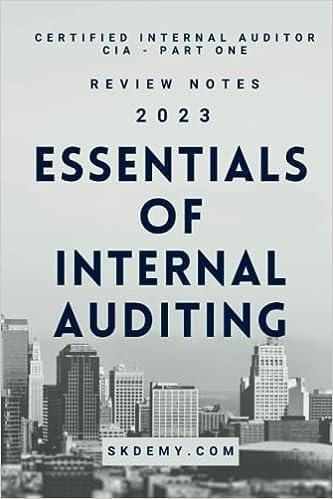Answered step by step
Verified Expert Solution
Question
1 Approved Answer
hello, I have this graded assignment due. I already posted this question many times here on chegg but all writers are saying the questions are
hello, I have this graded assignment due. I already posted this question many times here on chegg but all writers are saying the questions are incomplete or they need more information. This is all I have that's the way it was posted by the professor. so please, if it's possible to do the minimum even if the writer that's doing the exercise, isn't sure about the answers provided, i really don't mind. I really need to submit it and I would really appreciate it. thank you in advance. 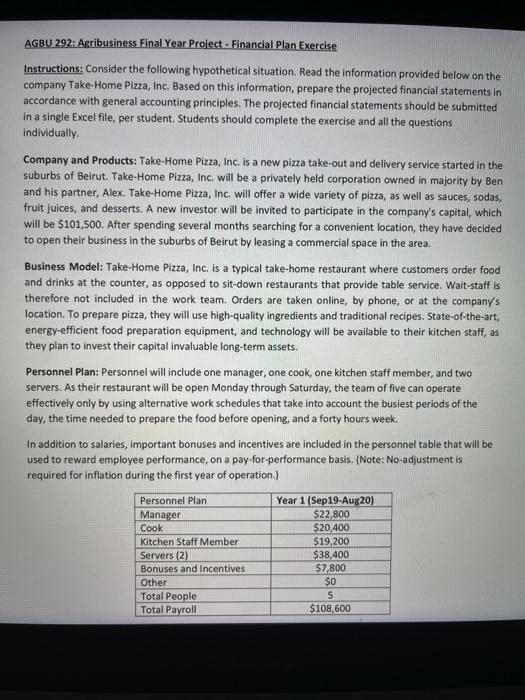
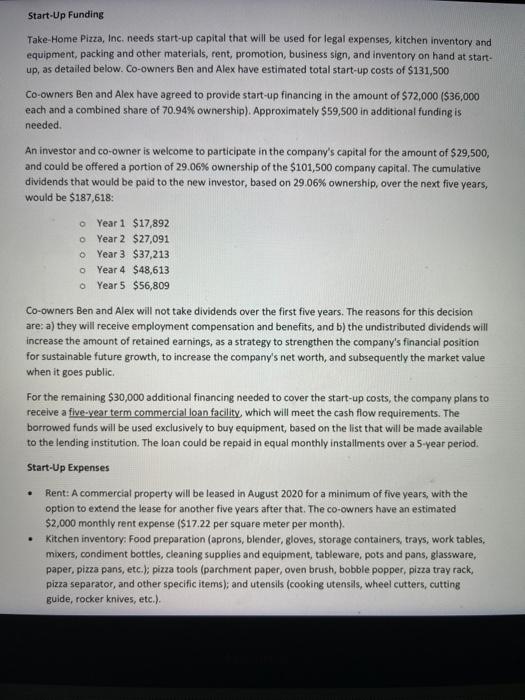

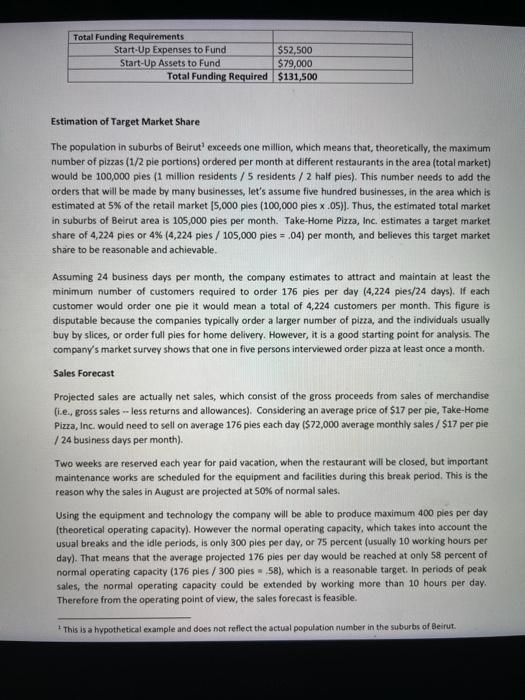

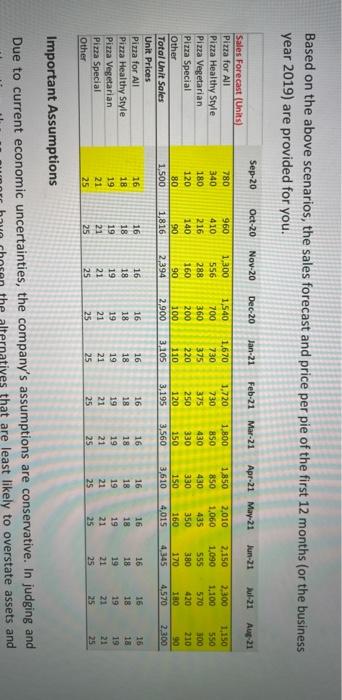
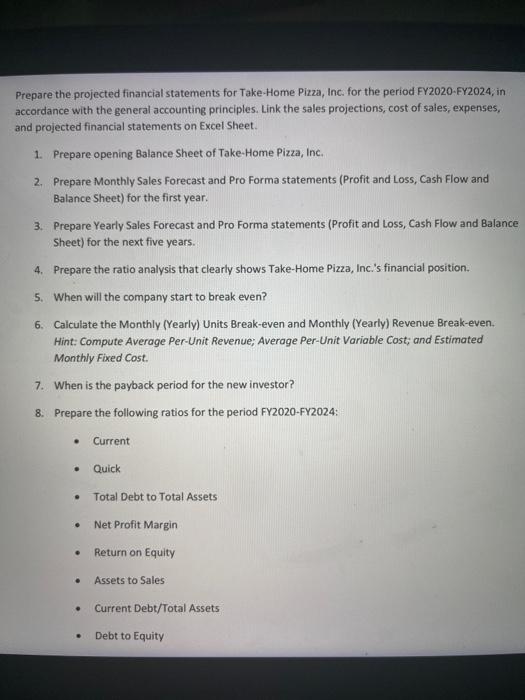
Start-Up Funding Take-Home Pizza, Inc. needs start-up capital that will be used for legal expenses, kitchen inventory and equipment packing and other materials, rent, promotion, business sign, and inventory on hand at start- up, as detailed below. Co-owners Ben and Alex have estimated total start-up costs of $131,500 Co-owners Ben and Alex have agreed to provide start-up financing in the amount of $72,000 ($36,000 each and a combined share of 70.94% ownership). Approximately $59,500 in additional funding is needed. An investor and co-owner is welcome to participate in the company's capital for the amount of $29,500, and could be offered a portion of 29.06% ownership of the $101,500 company capital. The cumulative dividends that would be paid to the new investor, based on 29.06% ownership, over the next five years, would be $187,618: Year 1 $17,892 Year 2 $27,091 Year 3 $37,213 o Year 4 $48,613 o Year 5 $56,809 Co-owners Ben and Alex will not take dividends over the first five years. The reasons for this decision are: a) they will receive employment compensation and benefits, and b) the undistributed dividends will increase the amount of retained earnings, as a strategy to strengthen the company's financial position for sustainable future growth, to increase the company's net worth, and subsequently the market value when it goes public For the remaining $30,000 additional financing needed to cover the start-up costs, the company plans to receive a five-year term commercial loan facility, which will meet the cash flow requirements. The borrowed funds will be used exclusively to buy equipment, based on the list that will be made available to the lending institution. The loan could be repaid in equal monthly installments over a 5-year period. Start-Up Expenses Rent: A commercial property will be leased in August 2020 for a minimum of five years, with the option to extend the lease for another five years after that. The co-owners have an estimated $2,000 monthly rent expense ($17.22 per square meter per month). Kitchen inventory: Food preparation (aprons, blender, gloves, storage containers, trays, work tables, mixers, condiment bottles, cleaning supplies and equipment tableware, pots and pans, glassware, paper, pizza pans, etc.); pizza tools (parchment paper, oven brush, bobble popper, pizza tray rack, pizza separator, and other specific items); and utensils (cooking utensils, wheel cutters, cutting guide, rocker knives, etc.) . . Kitchen Equipment: Pizza ovens, pizza dough equipment (digital scale, mixer, dough docker, automatic dough press, pizza sheeter, manual pizza press), pizza display merchandiser, refrigerated preparation tables, freezers, cooler package, and holding table with infrared warmers. Other expensed equipment: Neon pizza signs, tables, and chairs, coffee makers, coffee filters, tea dispensers, juice dispensers, cleaning equipment, dish machines, etc. Promotion expenses at start-up are initially estimated at $3,300 and will be used for various marketing information materials and advertisements. Legal expenses include business formation, advice and assistance, basic contract reviews, and general business advice Office supplies include desks, files, tape, record books, forms, etc Permit expenses are the additional costs incurred to operate legally in the suburbs of Beirut. . . Start-Up Assets . Long-term assets: $50,000 worth of equipment (long-term assets) will be expensed over the next five years, using the straight-line depreciation method. The company policy is to purchase only new, state-of-the-art, energy-efficient equipment from reliable suppliers in the food industry Inventory on hand at start-up includes specific ingredients for pizza preparation (flour, spices and pizza condiments), sauces, juices and other soft drinks, coffee, tea, toppings, parmesan cheese, cookie dough, breadsticks and different dessert items that can be ordered together with the main menu item. It also includes supplies that are used during the packing, sale, and delivery process, and miscellaneous supplies The cash requirement at start-up is estimated to be $14,000. Summary: Start-Up Expenses and Start-Up Assets Start-up Expenses Legal $2,200 Kitchen Inventory (Supplies) $6,000 Packing Materials $2,500 Kitchen Equipment $20,000 Rent $2,000 Promotion $3,300 Other Expensed Equipment $5,000 Business Sign $3,000 Permits $2.500 Office Supplies $2.000 Other (miscellaneous) $4,000 Total Start-up Expenses $52,500 Start-up Assets Cash Required $14,000 Start-up Inventory $15,000 Long term Assets $50,000 Total Assets $79,000 Total Funding Requirements Start-Up Expenses to Fund $52,500 Start-Up Assets to Fund $79,000 Total Funding Required $131,500 Estimation of Target Market Share The population in suburbs of Beirut' exceeds one million, which means that, theoretically, the maximum number of pizzas (1/2 pie portions) ordered per month at different restaurants in the area (total market) would be 100,000 pies (1 million residents / 5 residents /2 half ples). This number needs to add the orders that will be made by many businesses, let's assume five hundred businesses, in the area which is estimated at 5% of the retail market (5,000 ples (100,000 pies x .05)). Thus, the estimated total market in suburbs of Beirut area is 105,000 pies per month. Take-Home Pizza, Inc. estimates a target market share of 4,224 pies or 4% (4,224 pies / 105,000 pies = .04) per month, and believes this target market Share to be reasonable and achievable. Assuming 24 business days per month, the company estimates to attract and maintain at least the minimum number of customers required to order 176 pies per day (4,224 pies/24 days). If each customer would order one ple it would mean a total of 4,224 customers per month. This figure is disputable because the companies typically order a larger number of pizza, and the individuals usually buy by slices, or order full ples for home delivery. However, it is a good starting point for analysis. The company's market survey shows that one in five persons interviewed order pizza at least once a month. Sales Forecast Projected sales are actually net sales, which consist of the gross proceeds from sales of merchandise li.e., gross sales -- less returns and allowances). Considering an average price of $17 per ple, Take-Home Pizza, Inc. would need to sell on average 176 pies each day (572,000 average monthly sales / $17 per pie /24 business days per month). Two weeks are reserved each year for paid vacation, when the restaurant will be closed, but important maintenance works are scheduled for the equipment and facilities during this break period. This is the reason why the sales in August are projected at 50% of normal sales. Using the equipment and technology the company will be able to produce maximum 400 ples per day (theoretical operating capacity). However the normal operating capacity, which takes into account the usual breaks and the idle periods, is only 300 pies per day, or 75 percent (usually 10 working hours per day). That means that the average projected 176 pies per day would be reached at only 58 percent of normal operating capacity (176 ples / 300 ples - 58), which is a reasonable target. In periods of peak sales, the normal operating capacity could be extended by working more than 10 hours per day Therefore from the operating point of view, the sales forecast is feasible. This is a hypothetical example and does not reflect the actual population number in the suburbs of Bein Based on the above scenarios, the sales forecast and price per pie of the first 12 months for the business year 2019) are provided for you. 20 Dec 2011 Mar 11 Apr May A-11 70 1. 15 00 10 150 10 1.050 2100 LIDO Pirm for Healthy Style Plan Verona pical 1110 100 2.150 100 555 10 410 214 140 1.770 70 175 150 120 3.135 310 40 210 120 30 DO 11 320 110 1.105 1 200 M 100 ZO 130 1 2.60 330 150 1,610 401S 19 7100 DURS Unit Pris Punto I 16 16 18 16 16 16 18 19 23 16 TE 16 18 19 10 16 18 19 21 25 Ver Special Other 19 21 25 16 10 12 21 18 19 21 25 15 18 19 211 25 18 19 21 25 10 21 11 25 25 Important Assumptions Due to current economic uncertainties, the company's assumptions are conservative. In judging and estimating, the co-owners have chosen the alternatives that are least likely to overstate assets and income. General Assumptions Estimated sales growth Cost of goods sold of sales) Inventory of sales) Other Operating Expenses (% Sales) Payroll Taxes and Benefits Long-term Interest Rate Corporate Tax Rate Payment Delays Sales on Credit Sales Tax, VAT Inflation Rate Collection Period Target Inventory Accounts Payable FY2020 FY2021 FY2022 FY2023 FY2024 10% 10% SX % 52% 52% 52% 52% 52% 39% 39% 39% 39% 39% 0.5% 0.5% 0.5% 0.5% 0.5% 29% 29% 29% 29% 29% 12% 12% 12% 12% 12% 30% 30% 30% 30% 30% 30 30 30 30 30 15% 15% 15% 15% 15% 10% 10% 10% 10% 10% 5% 5% 5% 5% 5% Next month following sales 39% of current sales Cost of goods sold + Targeted Inventory (Ending) 1 - Targeted Inventory (Beginning) $ 108,600 per year $8,000 per year $1,200 per year $6,600 per year $9,000 per year A strait line method, no salvage value at the end of its useful life (5 years) Payroll Sales and Marketing and Other Expenses Office Supplies Utilities Insurance Depreciation Note: Costs/expenses following year 1 should be adjusted for inflation (which is hypothesized to be 5%). Questions Based on the above scenarios, the sales forecast and price per pie of the first 12 months (or the business year 2019) are provided for you. Sep-20 Oct-20 Nov-20 Dec-20 Jan-21 Feb-21 Mar 21 Apr-21 May-21 Jun-21 Jul-21 Aug-21 960 780 340 180 1,300 556 288 1,540 700 360 1.720 730 410 2,300 1.100 2,150 1,090 555 1,150 559 216 375 570 2,010 1,060 435 350 160 4,015 1,800 850 430 330 150 3.560 200 1.850 850 430 330 150 3,510 120 Sales Forecast (Units) Pizza for All Pizza Healthy Style Pizza Vegetarian Pizza Special Other Total Unit Sales Unit Prices Pizza for All Pizza Healthy Style Pizza Vegetarian Pizza Special Other 1,670 730 375 220 110 3, 105 160 100 210 140 90 1,816 380 170 80 1,500 90 2,394 250 120 3,195 100 2,900 420 180 4.570 90 2.300 4 345 15 16 18 19 21 25 16 18 19 21 25 16 18 19 21 25 16 18 19 21 25 16 18 19 21 25 16 18 19 21 25 16 18 19 21 25 16 18 19 21 25 16 18 19 21 25 16 18 19 21 25 16 18 19 21 19 21 25 Important Assumptions Due to current economic uncertainties, the company's assumptions are conservative. In judging and ernatives that are least likely to overstate assets and Prepare the projected financial statements for Take-Home Pizza, Inc. for the period FY2020-F2024, in accordance with the general accounting principles. Link the sales projections, cost of sales, expenses, and projected financial statements on Excel Sheet. 1. Prepare opening Balance Sheet of Take-Home Pizza, Inc. 2. Prepare Monthly Sales Forecast and Pro Forma statements (Profit and Loss, Cash Flow and Balance Sheet) for the first year. 3. Prepare Yearly Sales Forecast and Pro Forma statements (Profit and Loss, Cash Flow and Balance Sheet) for the next five years. 4. Prepare the ratio analysis that clearly shows Take-Home Pizza, Inc.'s financial position 5. When will the company start to break even? 6. Calculate the Monthly (Yearly) Units Break-even and Monthly (Yearly) Revenue Break-even. Hint: Compute Average Per-Unit Revenue; Average Per-Unit Variable Cost; and Estimated Monthly Fixed Cost 7. When is the payback period for the new investor? 8. Prepare the following ratios for the period FY2020-FY2024: Current Quick . Total Debt to Total Assets Net Profit Margin Return on Equity Assets to Sales Current Debt/Total Assets Debt to Equity Start-Up Funding Take-Home Pizza, Inc. needs start-up capital that will be used for legal expenses, kitchen inventory and equipment packing and other materials, rent, promotion, business sign, and inventory on hand at start- up, as detailed below. Co-owners Ben and Alex have estimated total start-up costs of $131,500 Co-owners Ben and Alex have agreed to provide start-up financing in the amount of $72,000 ($36,000 each and a combined share of 70.94% ownership). Approximately $59,500 in additional funding is needed. An investor and co-owner is welcome to participate in the company's capital for the amount of $29,500, and could be offered a portion of 29.06% ownership of the $101,500 company capital. The cumulative dividends that would be paid to the new investor, based on 29.06% ownership, over the next five years, would be $187,618: Year 1 $17,892 Year 2 $27,091 Year 3 $37,213 o Year 4 $48,613 o Year 5 $56,809 Co-owners Ben and Alex will not take dividends over the first five years. The reasons for this decision are: a) they will receive employment compensation and benefits, and b) the undistributed dividends will increase the amount of retained earnings, as a strategy to strengthen the company's financial position for sustainable future growth, to increase the company's net worth, and subsequently the market value when it goes public For the remaining $30,000 additional financing needed to cover the start-up costs, the company plans to receive a five-year term commercial loan facility, which will meet the cash flow requirements. The borrowed funds will be used exclusively to buy equipment, based on the list that will be made available to the lending institution. The loan could be repaid in equal monthly installments over a 5-year period. Start-Up Expenses Rent: A commercial property will be leased in August 2020 for a minimum of five years, with the option to extend the lease for another five years after that. The co-owners have an estimated $2,000 monthly rent expense ($17.22 per square meter per month). Kitchen inventory: Food preparation (aprons, blender, gloves, storage containers, trays, work tables, mixers, condiment bottles, cleaning supplies and equipment tableware, pots and pans, glassware, paper, pizza pans, etc.); pizza tools (parchment paper, oven brush, bobble popper, pizza tray rack, pizza separator, and other specific items); and utensils (cooking utensils, wheel cutters, cutting guide, rocker knives, etc.) . . Kitchen Equipment: Pizza ovens, pizza dough equipment (digital scale, mixer, dough docker, automatic dough press, pizza sheeter, manual pizza press), pizza display merchandiser, refrigerated preparation tables, freezers, cooler package, and holding table with infrared warmers. Other expensed equipment: Neon pizza signs, tables, and chairs, coffee makers, coffee filters, tea dispensers, juice dispensers, cleaning equipment, dish machines, etc. Promotion expenses at start-up are initially estimated at $3,300 and will be used for various marketing information materials and advertisements. Legal expenses include business formation, advice and assistance, basic contract reviews, and general business advice Office supplies include desks, files, tape, record books, forms, etc Permit expenses are the additional costs incurred to operate legally in the suburbs of Beirut. . . Start-Up Assets . Long-term assets: $50,000 worth of equipment (long-term assets) will be expensed over the next five years, using the straight-line depreciation method. The company policy is to purchase only new, state-of-the-art, energy-efficient equipment from reliable suppliers in the food industry Inventory on hand at start-up includes specific ingredients for pizza preparation (flour, spices and pizza condiments), sauces, juices and other soft drinks, coffee, tea, toppings, parmesan cheese, cookie dough, breadsticks and different dessert items that can be ordered together with the main menu item. It also includes supplies that are used during the packing, sale, and delivery process, and miscellaneous supplies The cash requirement at start-up is estimated to be $14,000. Summary: Start-Up Expenses and Start-Up Assets Start-up Expenses Legal $2,200 Kitchen Inventory (Supplies) $6,000 Packing Materials $2,500 Kitchen Equipment $20,000 Rent $2,000 Promotion $3,300 Other Expensed Equipment $5,000 Business Sign $3,000 Permits $2.500 Office Supplies $2.000 Other (miscellaneous) $4,000 Total Start-up Expenses $52,500 Start-up Assets Cash Required $14,000 Start-up Inventory $15,000 Long term Assets $50,000 Total Assets $79,000 Total Funding Requirements Start-Up Expenses to Fund $52,500 Start-Up Assets to Fund $79,000 Total Funding Required $131,500 Estimation of Target Market Share The population in suburbs of Beirut' exceeds one million, which means that, theoretically, the maximum number of pizzas (1/2 pie portions) ordered per month at different restaurants in the area (total market) would be 100,000 pies (1 million residents / 5 residents /2 half ples). This number needs to add the orders that will be made by many businesses, let's assume five hundred businesses, in the area which is estimated at 5% of the retail market (5,000 ples (100,000 pies x .05)). Thus, the estimated total market in suburbs of Beirut area is 105,000 pies per month. Take-Home Pizza, Inc. estimates a target market share of 4,224 pies or 4% (4,224 pies / 105,000 pies = .04) per month, and believes this target market Share to be reasonable and achievable. Assuming 24 business days per month, the company estimates to attract and maintain at least the minimum number of customers required to order 176 pies per day (4,224 pies/24 days). If each customer would order one ple it would mean a total of 4,224 customers per month. This figure is disputable because the companies typically order a larger number of pizza, and the individuals usually buy by slices, or order full ples for home delivery. However, it is a good starting point for analysis. The company's market survey shows that one in five persons interviewed order pizza at least once a month. Sales Forecast Projected sales are actually net sales, which consist of the gross proceeds from sales of merchandise li.e., gross sales -- less returns and allowances). Considering an average price of $17 per ple, Take-Home Pizza, Inc. would need to sell on average 176 pies each day (572,000 average monthly sales / $17 per pie /24 business days per month). Two weeks are reserved each year for paid vacation, when the restaurant will be closed, but important maintenance works are scheduled for the equipment and facilities during this break period. This is the reason why the sales in August are projected at 50% of normal sales. Using the equipment and technology the company will be able to produce maximum 400 ples per day (theoretical operating capacity). However the normal operating capacity, which takes into account the usual breaks and the idle periods, is only 300 pies per day, or 75 percent (usually 10 working hours per day). That means that the average projected 176 pies per day would be reached at only 58 percent of normal operating capacity (176 ples / 300 ples - 58), which is a reasonable target. In periods of peak sales, the normal operating capacity could be extended by working more than 10 hours per day Therefore from the operating point of view, the sales forecast is feasible. This is a hypothetical example and does not reflect the actual population number in the suburbs of Bein Based on the above scenarios, the sales forecast and price per pie of the first 12 months for the business year 2019) are provided for you. 20 Dec 2011 Mar 11 Apr May A-11 70 1. 15 00 10 150 10 1.050 2100 LIDO Pirm for Healthy Style Plan Verona pical 1110 100 2.150 100 555 10 410 214 140 1.770 70 175 150 120 3.135 310 40 210 120 30 DO 11 320 110 1.105 1 200 M 100 ZO 130 1 2.60 330 150 1,610 401S 19 7100 DURS Unit Pris Punto I 16 16 18 16 16 16 18 19 23 16 TE 16 18 19 10 16 18 19 21 25 Ver Special Other 19 21 25 16 10 12 21 18 19 21 25 15 18 19 211 25 18 19 21 25 10 21 11 25 25 Important Assumptions Due to current economic uncertainties, the company's assumptions are conservative. In judging and estimating, the co-owners have chosen the alternatives that are least likely to overstate assets and income. General Assumptions Estimated sales growth Cost of goods sold of sales) Inventory of sales) Other Operating Expenses (% Sales) Payroll Taxes and Benefits Long-term Interest Rate Corporate Tax Rate Payment Delays Sales on Credit Sales Tax, VAT Inflation Rate Collection Period Target Inventory Accounts Payable FY2020 FY2021 FY2022 FY2023 FY2024 10% 10% SX % 52% 52% 52% 52% 52% 39% 39% 39% 39% 39% 0.5% 0.5% 0.5% 0.5% 0.5% 29% 29% 29% 29% 29% 12% 12% 12% 12% 12% 30% 30% 30% 30% 30% 30 30 30 30 30 15% 15% 15% 15% 15% 10% 10% 10% 10% 10% 5% 5% 5% 5% 5% Next month following sales 39% of current sales Cost of goods sold + Targeted Inventory (Ending) 1 - Targeted Inventory (Beginning) $ 108,600 per year $8,000 per year $1,200 per year $6,600 per year $9,000 per year A strait line method, no salvage value at the end of its useful life (5 years) Payroll Sales and Marketing and Other Expenses Office Supplies Utilities Insurance Depreciation Note: Costs/expenses following year 1 should be adjusted for inflation (which is hypothesized to be 5%). Questions Based on the above scenarios, the sales forecast and price per pie of the first 12 months (or the business year 2019) are provided for you. Sep-20 Oct-20 Nov-20 Dec-20 Jan-21 Feb-21 Mar 21 Apr-21 May-21 Jun-21 Jul-21 Aug-21 960 780 340 180 1,300 556 288 1,540 700 360 1.720 730 410 2,300 1.100 2,150 1,090 555 1,150 559 216 375 570 2,010 1,060 435 350 160 4,015 1,800 850 430 330 150 3.560 200 1.850 850 430 330 150 3,510 120 Sales Forecast (Units) Pizza for All Pizza Healthy Style Pizza Vegetarian Pizza Special Other Total Unit Sales Unit Prices Pizza for All Pizza Healthy Style Pizza Vegetarian Pizza Special Other 1,670 730 375 220 110 3, 105 160 100 210 140 90 1,816 380 170 80 1,500 90 2,394 250 120 3,195 100 2,900 420 180 4.570 90 2.300 4 345 15 16 18 19 21 25 16 18 19 21 25 16 18 19 21 25 16 18 19 21 25 16 18 19 21 25 16 18 19 21 25 16 18 19 21 25 16 18 19 21 25 16 18 19 21 25 16 18 19 21 25 16 18 19 21 19 21 25 Important Assumptions Due to current economic uncertainties, the company's assumptions are conservative. In judging and ernatives that are least likely to overstate assets and Prepare the projected financial statements for Take-Home Pizza, Inc. for the period FY2020-F2024, in accordance with the general accounting principles. Link the sales projections, cost of sales, expenses, and projected financial statements on Excel Sheet. 1. Prepare opening Balance Sheet of Take-Home Pizza, Inc. 2. Prepare Monthly Sales Forecast and Pro Forma statements (Profit and Loss, Cash Flow and Balance Sheet) for the first year. 3. Prepare Yearly Sales Forecast and Pro Forma statements (Profit and Loss, Cash Flow and Balance Sheet) for the next five years. 4. Prepare the ratio analysis that clearly shows Take-Home Pizza, Inc.'s financial position 5. When will the company start to break even? 6. Calculate the Monthly (Yearly) Units Break-even and Monthly (Yearly) Revenue Break-even. Hint: Compute Average Per-Unit Revenue; Average Per-Unit Variable Cost; and Estimated Monthly Fixed Cost 7. When is the payback period for the new investor? 8. Prepare the following ratios for the period FY2020-FY2024: Current Quick . Total Debt to Total Assets Net Profit Margin Return on Equity Assets to Sales Current Debt/Total Assets Debt to Equity 




the next picture will be a close up of the sales forcast table ( which includes yellow)

the next picture is the questions, and it's all I have. 6 pages in total.

Step by Step Solution
There are 3 Steps involved in it
Step: 1

Get Instant Access to Expert-Tailored Solutions
See step-by-step solutions with expert insights and AI powered tools for academic success
Step: 2

Step: 3

Ace Your Homework with AI
Get the answers you need in no time with our AI-driven, step-by-step assistance
Get Started


